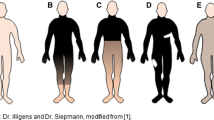Abstract
Background
Ross syndrome is a rare disorder characterized by tonic pupils, hyporeflexia, and segmental anhidrosis. We sought to characterize the clinical presentation, associated autoimmune disorders, and autonomic profile in patients with Ross syndrome to further elucidate its pathophysiology.
Methods
We performed a retrospective chart review of all patients who underwent a thermoregulatory sweat test (TST) between 1998 and 2020 and had confirmation of the diagnosis of Ross syndrome by an autonomic disorders specialist. Standardized autonomic reflex testing was reviewed when available.
Results
Twenty-six patients with Ross syndrome were identified. The most common initial reported manifestation was an abnormal segmental sweating response in 16 patients (described as hyperhidrosis in 12 patients and anhidrosis in 4 patients) while a tonic pupil was the initial manifestation in 10 patients. Other commonly reported symptoms included fatigue, chronic cough, and increased urinary frequency. An associated autoimmune disorder was identified in one patient. Positive autoantibodies were found in a minority of patients often with unclear clinical significance. Distributions of anhidrosis encountered were segmental (n = 15), widespread (n = 7), and global (n = 4). Well-circumscribed small areas of preserved sweating within areas of anhidrosis were observed in the majority of patients (88.5%). Anhidrosis progressed slowly over time and sudomotor dysfunction was predominantly (post)ganglionic. Cardiovagal and adrenergic functions were preserved in most patients.
Conclusions
The pattern of autonomic dysfunction in Ross syndrome is suggestive of a limited autonomic ganglioneuropathy. Sudomotor impairment is prominent and should be the focus of symptomatic management; however, clinicians should be aware of symptoms beyond the classic triad.



Similar content being viewed by others
References
Agmon-Levin N, Damoiseaux J, Kallenberg C, Sack U, Witte T, Herold M, Bossuyt X, Musset L, Cervera R, Plaza-Lopez A, Dias C, Sousa MJ, Radice A, Eriksson C, Hultgren O, Viander M, Khamashta M, Regenass S, Andrade LE, Wiik A, Tincani A, Rönnelid J, Bloch DB, Fritzler MJ, Chan EK, Garcia-De La Torre I, Konstantinov KN, Lahita R, Wilson M, Vainio O, Fabien N, Sinico RA, Meroni P, Shoenfeld Y (2014) International recommendations for the assessment of autoantibodies to cellular antigens referred to as anti-nuclear antibodies. Ann Rheum Dis 73:17–23
Baran A, Balbaba M, Demir CF, Ozdemir HH (2014) A case of Ross syndrome presented with Horner and chronic cough. J Neurosci Rural Pract 5:394–397
Beier C, Ernemann U, Gerloff C (2004) Moving along with Ross syndrome—a patient with a 50 years history. J Neurol 251:1402–1403
Bergmann I, Dauphin M, Naumann M, Flachenecker P, Müllges W, Koltzenburg M, Sommer C (1998) Selective degeneration of sudomotor fibers in Ross syndrome and successful treatment of compensatory hyperhidrosis with botulinum toxin. Muscle Nerve 21:1790–1793
Cheshire WP Jr (2016) Thermoregulatory disorders and illness related to heat and cold stress. Auton Neurosci Basic Clin 196:91–104
Coon EA, Cheshire WP Jr (2020) Sweating disorders. Continuum (Minneapolis, Minn) 26:116–137
Csak T, Folhoffer A, Horvath A, Halász J, Diczházi C, Schaff Z, Szalay F (2006) Holmes-Adie syndrome, autoimmune hepatitis and celiac disease: a case report. World J Gastroenterol 12:1485–1487
Donadio V, Cortelli P, Elam M, Di Stasi V, Montagna P, Holmberg B, Giannoccaro MP, Bugiardini E, Avoni P, Baruzzi A, Liguori R (2010) Autonomic innervation in multiple system atrophy and pure autonomic failure. J Neurol Neurosurg Psychiatry 81:1327–1335
Donadio V, Cortelli P, Giannoccaro MP, Nolano M, Di Stasi V, Baruzzi A, Liguori R (2012) Muscle and skin sympathetic activities in Ross syndrome. Clin Neurophysiol 123:1639–1643
Fealey RD, Low PA, Thomas JE (1989) Thermoregulatory sweating abnormalities in diabetes mellitus. Mayo Clin Proc 64:617–628
Fileccia E, Liguori R, Cortelli P, Donadio V (2017) Absent cardiac and muscle sympathetic nerve activities involvement in Ross syndrome: a follow-up study. Auton Neurosci Basic Clin 208:161–164
Filikci Z, Horsten HH, Lindelof M (2020) Ross syndrome: a patient with a 23-year history. Case Rep Neurol 12:132–135
Harriman DG, Garland H (1968) The pathology of Adie’s syndrome. Brain 91:401–418
Kimber J, Mitchell D, Mathias CJ (1998) Chronic cough in the Holmes-Adie syndrome: association in five cases with autonomic dysfunction. J Neurol Neurosurg Psychiatry 65:583–586
Kimpinski K, Iodice V, Sandroni P, Fealey RD, Vernino S, Low PA (2009) Sudomotor dysfunction in autoimmune autonomic ganglionopathy. Neurology 73:1501–1506
Lamotte G, Sandroni P (2021) A case of Ross syndrome associated with systemic sclerosis. Clin Auton Res (Online ahead of print)
Low PA (1993) Autonomic nervous system function. J Clin Neurophysiol 10:14–27
Low PA (1993) Composite autonomic scoring scale for laboratory quantification of generalized autonomic failure. Mayo Clin Proc 68:748–752
Low PA (2004) Evaluation of sudomotor function. Clin Neurophysiol 115:1506–1513
Ma M, Yao J, Chen Y, Liu H, Xia D, Tian H, Wang X, Wu E, Wang X, Ding X (2020) Is ross syndrome a new type of synucleinopathy? A Brief Research Report. Front Neurosci 14:635
Macefield VG (2012) Selective autonomic failure: Ross syndrome. Clin Neurophysiol 123:1479–1480
Mishra AK, Kharkongor M, Kuriakose CK, George AA, Peter D, Carey RAB, Mathew V, Hansdak SG (2017) Is ross syndrome an autoimmune entity? A case series of 11 patients. Can J Neurol Sci 44:318–321
Nolano M, Provitera V, Perretti A, Stancanelli A, Saltalamacchia AM, Donadio V, Manganelli F, Lanzillo B, Santoro L (2006) Ross syndrome: a rare or a misknown disorder of thermoregulation? A skin innervation study on 12 subjects. Brain 129:2119–2131
Pashnina IA, Krivolapova IM, Fedotkina TV, Ryabkova VA, Chereshneva MV, Churilov LP, Chereshnev VA (2021) Antinuclear autoantibodies in health: autoimmunity is not a synonym of autoimmune disease. Antibodies (Basel) 10
Pickering TG, Sleight P (1969) Quantitative index of baroreflex activity in normal and hypertensive subjects using Valsalva’s manoeuvre. Br Heart J 31:392
Ross AT (1958) Progressive selective sudomotor denervation; a case with coexisting Adie’s syndrome. Neurology 8:809–817
Shin RK, Galetta SL, Ting TY, Armstrong K, Bird SJ (2000) Ross syndrome plus: beyond horner, Holmes-Adie, and harlequin. Neurology 55:1841–1846
Sommer C, Lindenlaub T, Zillikens D, Toyka KV, Naumann M (2002) Selective loss of cholinergic sudomotor fibers causes anhidrosis in Ross syndrome. Ann Neurol 52:247–250
Vasudevan B, Sawhney M, Vishal S (2010) Ross syndrome with ana positivity: a clue to possible autoimmune origin and treatment with intravenous immunoglobulin. Indian J Dermatol 55:274–276
Vogel ER, Sandroni P, Low PA (2005) Blood pressure recovery from Valsalva maneuver in patients with autonomic failure. Neurology 65:1533–1537
Weller M, Wilhelm H, Sommer N, Dichgans J, Wiethölter H (1992) Tonic pupil, areflexia, and segmental anhidrosis: two additional cases of Ross syndrome and review of the literature. J Neurol 239:231–234
Funding
Supported by NIH (P01NS44233, U54NS065736, K23NS075141, R01 FD004789, R01 NS092625), Cure MSA Foundation, and CTSA Grant Number UL1 TR002377 Dominium Foundation Career Development Award in Neurodegenerative Disease Research in memory of Jack W. Safar from the National Center for Advancing Translational Science (NCATS).
Author information
Authors and Affiliations
Corresponding author
Ethics declarations
Conflicts of interest
None of the authors has a conflict of interest.
Rights and permissions
About this article
Cite this article
Lamotte, G., Sandroni, P., Cutsforth-Gregory, J.K. et al. Clinical presentation and autonomic profile in Ross syndrome. J Neurol 268, 3852–3860 (2021). https://doi.org/10.1007/s00415-021-10531-8
Received:
Revised:
Accepted:
Published:
Issue Date:
DOI: https://doi.org/10.1007/s00415-021-10531-8




